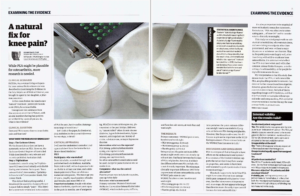Journal reference: Steels E, Venkatesh R, Steels E, Vitetta G, Vitetta L. A double-blind randomized placebo controlled study assessing safety, tolerability and efficacy of palmitoylethanolamide for symptoms of knee osteoarthritis. Inflammopharmacology 2019 Jun;27(3):475-85.
Link: http://dx.doi.org/10.1007/s10787-019-00582-9
Published: March 2019
 Evidence cookie says… |
Palmitoylethanolamide (PEA) cannot be recommended as a routine therapy for knee osteoarthritis.
|
 An abridged version of this article was first published in the September-October 2019, which is the final print issue, of Medical Observer, under the title “A natural fix for knee pain”.
An abridged version of this article was first published in the September-October 2019, which is the final print issue, of Medical Observer, under the title “A natural fix for knee pain”.
It also also published in the AusDoc.Plus online platform under the title, “Can this CAM compound help with knee pain?” on 25 September 2019.
Tam M. A natural fix for knee pain? Medical Observer. 2019 September-October. pp 34-5.
Clinical scenario
Fatima, a 59-year-old lady living with painful knee osteoarthritis, who was described in “Examining the Evidence” in the July 2019 issue of Medical Observer, was brought in again by her daughter, a pharmacy assistant. In this consultation, she raised that she had seen some patients take a new “natural” treatment, palmitoylethanolamide (PEA), for osteoarthritis. I recognised this substance from an online GP forum, with several members having had patients prescribed it by a pain physician. So, what is the evidence?
Clinical question
Does oral palmitoylethanolamide (PEA) improve knee osteoarthritis pain and function?
What does the research evidence say?
Step 1: The Cochrane Library
The Cochrane Library does not have a systematic review on PEA. However, the Cochrane Central Register of Controlled Trials does identify a very relevant and recently published Australian trial [1].
Step 2: TripDatabase
I conducted a search using the TripDatabase PICO search tool initially with the following search terms (Participant: “knee osteoarthritis”, Intervention: “palmitoylethanolamide”, Comparator: blank, Outcomes: blank). This did not find anything useful. I broadened the search by changing the participant field to simply “pain”. This identified a systematic review and meta-analysis of PEA for pain, but it was for a heterogenous range of conditions [2].
Let’s look at the paper by Steels et al. 2019 published in the journal Inflammopharmacology in detail [1].
Critical appraisal
I will use the randomised controlled trial appraisal sheet from the Centre for Evidence Based Medicine [3].
PICO
Participants: who was studied?
111 adults, recruited through local published media in Brisbane, Australia from 2016 to 2018, with a diagnosis of osteoarthritis in at least one knee, and a minimum pain level of 4 out of 10 on a numerical rating score. The mean age was 57 years, roughly equal numbers of males and females, and mean BMI of 27.
Important exclusions: people with other forms of arthritis, significant joint injury in the past 6 months, use of analgesics (e.g., NSAIDs) or natural therapies (e.g., glucosamine) in the past 30 days, BMI over 35, “uncontrolled” other chronic disease (diabetes, hypercholesterolaemia, hypertension), anticoagulant use, history of stroke, substance use, or a major depressive disorder.
Intervention: what was the exposure?
- PEA 300 mg: palmitoylethanolamide 150 mg, 1 cap twice daily
- PEA 600 mg: palmitoylethanolamide 300 mg, 1 cap twice daily
No other osteoarthritis medication could be used, except for paracetamol as rescue medication.
Comparator: what was the control/alternative?
placebo group: matched placebo capsules, 1 cap twice daily
Outcomes: what was measured?
Primary outcome: Western Ontario and McMaster Universities Osteoarthritis Index (WOMAC), which includes pain, stiffness, and function sub-scores, at week 4 and week 8.
Internal validity: are the trial results valid?
Randomised patient assignment?
Yes. The randomisation was generated by computer by an “independent” person. The PEA and placebo capsules were delivered to the investigators in identical appearing containers, numbered from 001 to 120. On enrolment, participants were allocated to the next available number.
Groups similar at the start?
Yes. There did not appear to be any important differences between the three groups.
Groups treated equally apart from assigned treatment?
Yes.
All patients accounted for?
Yes. Of the 111 patients randomised, 10% withdrew. An intention to treat approach was used, with 110 participants included in the analysis.
Measures objective? Or patients and clinicians kept blinded?
Probably, yes. Self-reported pain is a subjective measure. Nonetheless, it is likely that both the investigators and patients were kept blinded even though adequacy of blinding was not measured in this study.
What were the results?
Primary outcomes – WOMAC pain scores: baseline and week 8:
- PEA 300 mg group: 8.9 to 4.5
- PEA 600 mg group: 9.2 to 3.9
- placebo group: 9.0 to 6.8
- interpretation: the point estimate differences at 8 weeks were “statistically significant” [see StatFacts] between both doses of PEA and placebo. However, it is likely the differences between PEA and placebo is not clinically important. The minimum clinically important difference (MCID) for improvement of knee osteoarthritis on the WOMAC pain score is 7.09 [4].
WOMAC function scores: baseline and week 8:
- PEA 300 mg group: 28.1 to 17.7
- PEA 600 mg group: 30.2 to 14.2
- placebo group: 29.1 to 22.2
- interpretation: the point estimates differences at 8 weeks were statistically significant between PEA 600 mg and placebo. Like the pain sub-score, this difference might not be important as the MCID for improvement of knee osteoarthritis on the WOMAC function score is 11.25 [4].
Discussion and conclusion
Palmitoylethanolamide (PEA) is a compound that is thought to have effects on the endocannabinoid system [5]. Prior reviews of the limited evidence supports the notion that it may have analgesic properties, and seems to have been well tolerated by participants in short-term research settings [2, 5]. This study supports the notion that PEA might have some effect on knee osteoarthritis pain compared to placebo [1]. However, the effect sizes were not impressive, and on average, did not appear to be larger than the minimum clinically important differences for knee osteoarthritis [4]. It is always important to be sceptical of more enthusiastic author statements, for instance, “PEA was effective for attenuating pain… of knee OA” [1], and consider what is clinically meaningful.
This study recruited people with no substantial comorbidities, who were not obese, and were taking no other analgesia other than paracetamol, and without a major depressive or substance use disorder. That is, the participants were largely well, other than living with mild to moderate knee osteoarthritis. It is unknown what effect that PEA may have when used with other common osteoarthritis therapies, or in the setting of multimorbidity, or for people living with more severe disease.
My interpretation is that this study does demonstrate that PEA, or substances like PEA, are plausible potential treatments that deserve further research and investigation. However, given the limited nature of the current evidence-base, the lack of clarity regarding dosage and formulation, and that it isn’t available in Australia without special order and compounding, PEA cannot be recommended as a routine therapy for knee osteoarthritis in primary care.
Stat Facts
Statistical significance
The term “statistical significance” and the threshold reasoning that it engenders [6] is highly problematic. A statistically significant result is simply one that met an arbitrary criterion of unusualness, in a mathematical sense, within the framework of the statistical model. It doesn’t tell us the probability that the result is true, and certainly not whether it is important [7]. It should be noted that in 2019, the American Statistical Association recommended that both the term and use of “statistical significance” be abandoned [8, 9].
References
- Steels E, Venkatesh R, Steels E, Vitetta G, Vitetta L. A double-blind randomized placebo controlled study assessing safety, tolerability and efficacy of palmitoylethanolamide for symptoms of knee osteoarthritis. Inflammopharmacology 2019 Jun;27(3):475-85.
- Artukoglu BB, Beyer C, Zuloff-Shani A, Brener E, Bloch MH. Efficacy of Palmitoylethanolamide for Pain: A Meta-Analysis. Pain Physician 2017 Jul;20(5):353-62.
- Centre for Evidence-Based Medicine. Critical Appraisal tools. 2014; Available from: http://www.cebm.net/critical-appraisal/
- Angst F, Benz T, Lehmann S, Aeschlimann A, Angst J. Multidimensional minimal clinically important differences in knee osteoarthritis after comprehensive rehabilitation: a prospective evaluation from the Bad Zurzach Osteoarthritis Study. RMD Open 2018;4(2):e000685.
- Gabrielsson L, Mattsson S, Fowler CJ. Palmitoylethanolamide for the treatment of pain: pharmacokinetics, safety and efficacy. Br J Clin Pharmacol 2016 Oct;82(4):932-42.
- Tam CWM, Khan A, Knight A, Rhee J, McLean K, Price K. How doctors conceptualise P values. Australian Journal of General Practice 2018 09/26;47:705-10.
- Greenland S, Senn SJ, Rothman KJ, et al. Statistical tests, P values, confidence intervals, and power: a guide to misinterpretations. Eur J Epidemiol 2016 Apr;31(4):337-50.
- Wasserstein RL, Schirm AL, Lazar NA. Moving to a World Beyond “p < 0.05”. The American Statistician 2019 2019/03/29;73(sup1):1-19.
- McShane BB, Gal D, Gelman A, Robert C, Tackett JL. Abandon Statistical Significance. The American Statistician 2019 2019/03/29;73(sup1):235-45.

Recent Comments